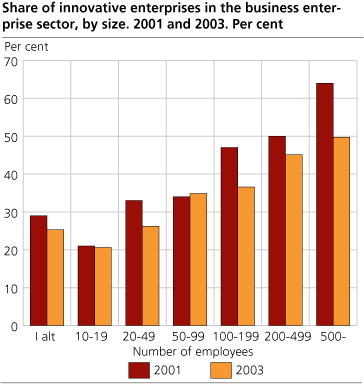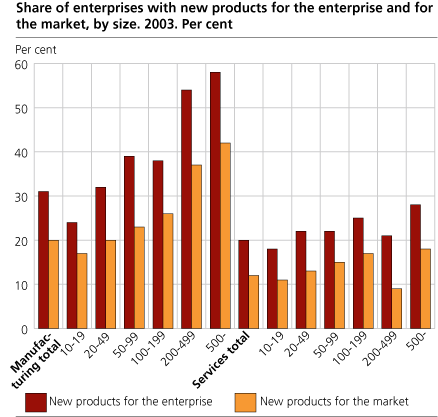Content
Published:
This is an archived release.
Norwegian enterprises still not very innovative
Results from the combined R&D and innovation survey for 2003( 1 ) show that 25 per cent of Norwegian enterprises introduced new or significantly improved products or processes in the period 2001-2003 and can be defined as innovative. This is somewhat lower than for the period 1999-2001, when the figure was 29 per cent.
The proportion of innovative enterprises had fallen particularly for the service sector, whereas it was slightly higher for the manufacturing sector. The decline was present among the largest enterprises and across all industries.
Lower share of enterprises with new innovations
The majority of the innovative enterprises have introduced new or significantly improved products for the enterprise, 20 per cent. However, only 13 per cent have introduced products that are new for the market. This is slightly higher than in 2001. Although there is a decrease in the proportion of innovative enterprises in total, a higher proportion of the innovative enterprises introduce products that are new for the market.
13 percent of the enterprises have introduced processes that are new or significantly improved for the enterprise. We do not have information on whether these processes were new for the market too. A large number of the enterprises that introduced new processes also introduced new products. Relatively few enterprises only introduce new processes.
Manufacturing ahead
Manufacturing enterprises are more innovative than service enterprises. Whereas 38 per cent of manufacturing enterprises are innovative according to the survey, the corresponding figure is 24 per cent for service enterprises. This gap is in fact larger than in the period 1999-2001, due to an increase of manufacturing enterprises and a decrease of service enterprises among all innovative enterprises. Some industries stand out as highly innovative. Within production of communication equipment 68 per cent of the enterprises are innovative. Within medical equipment industry and chemical industry the percentages are 55 and 54 respectively. The dominating service industries are telecommunications and computer and related activities with a share of innovating enterprises of 51 and 59 per cent respectively.
Large enterprises more often innovative
The innovation intensity varies significantly according to the size of the enterprise. A larger proportion of large enterprises have introduced new products or processes than the smaller enterprises. For the whole business enterprise sector, 48 per cent of enterprises with 200 employees or more are innovative, while the figure for enterprises with 10-19 employees was 21 per cent. The difference between small and large enterprises is greater in the manufacturing sector than in the service sector. 64 per cent of large manufacturing enterprises were involved in innovation activities, compared with 29 per cent of small ones. In the service industry only 32 per cent of large enterprises were involved in innovation, compared with 22 per cent of small ones.
Tables:
- Table 1 Enterprises with innovation. 2003. Per cent of population
- Table 2 Enterprises with innovation. 2003. Per cent of population
- Table 3 Number of enterprises with innovation and new or significantly improved products in per cent of turnover. 2003
- Table 4 Number of enterprises with innovation and new or significantly improved products in per cent of turnover, by sector and size classes. 2003
- Table 5 New or significantly improved products in per cent of turnover, by sector and size classes. 2003
Contact
-
Lars Wilhelmsen
E-mail: lars.wilhelmsen@ssb.no
tel.: (+47) 40 90 24 35


